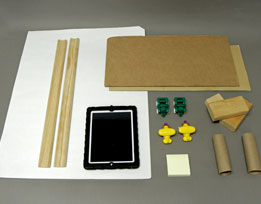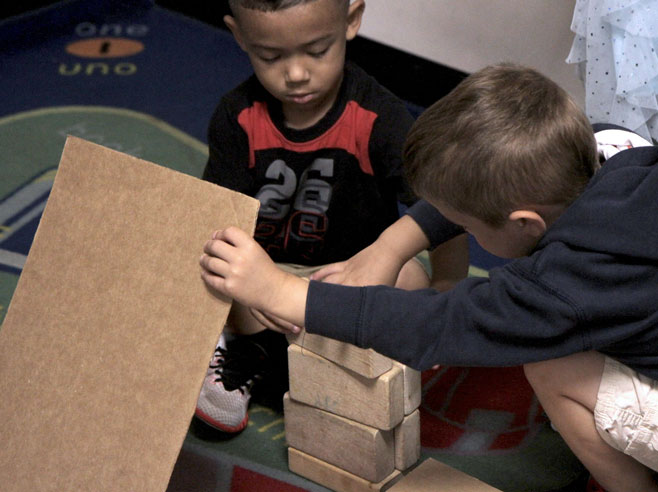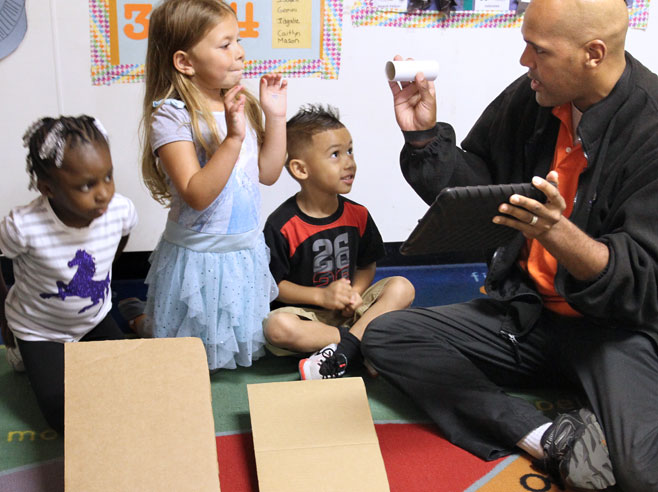Children compare the distance two identical objects travel when they roll down a steep and a gentle ramp. They use the Steep & Gentle Ramps tool in their digital Ramps Journal to make predictions and document and analyze their results.
Materials

- Steep & Gentle Ramps tool in the digital Ramps Journal on 1 or more iPads (Ideally, use a different iPad for each Guided Small Group.)
- 2 cardboard panels of equal length (18″–24″ long)
- Wooden unit blocks or books to prop up ramps (The gentle ramp should be about 1″ high (1 unit block); the steep ramp should be about 3″ high (3 unit blocks).)
- 2 cardboard toilet paper tubes
- 2 identical toy cars
- 2 identical toy trucks
- 2 rulers or unsharpened pencils to use as “starting gates”
- Small sticky note
- Optional: Chart paper or poster board (to provide a smooth, even roll-out area)
- Optional: Tape measure
Preparation
- Familiarize yourself with the Steep & Gentle Ramps tool. Audio and text directions in the app will walk you step by step through this integrated hands-on and digital activity.
- Test your materials to make sure that the “identical” toy vehicles roll equally smoothly and that you are providing sufficient roll-out space for the tubes and toy vehicles as they come off the ramps.
Directions: Lesson 6
Guided Small Group
- Ask children to help you set up a gentle and a steep cardboard ramp side by side. For example, a gentle ramp can be created using one unit block, and the steep ramp using three unit blocks. If you wish, place chart paper or poster board on the floor to make a smooth surface for the roll-out area.
- Invite children to compare the two ramps. How are the ramps different? Which ramp is steep? Which ramp is gentle?
- Show children the two toilet paper tubes that they will send down the ramps. Do these two tubes look the same? Which ramp do you predict will make a tube roll farther: the steep ramp or the gentle ramp? Encourage children to listen to and build on their classmates’ responses. Possible discussion ideas:
- Do you agree with (child’s name)’s prediction?
- Why do you think the (steep) ramp will make the tube go farther? Place a sticky note next to the ramp that most children think will make the tube go farthest.
- Have two children place a toilet paper tube at the top of each ramp, behind a pencil or ruler “starting gate.” Explain that when their classmates say Go! they will lift the “gate” and let the tubes roll down the ramps. (Using a starting gate ensures that a tube does not get an extra push at the top of the ramp.)
- Remind children that they will leave the tubes where they stop, so everyone can observe which one went farther. Lead the rest of the group in chanting, Ready? Set? Go!
- Invite children to observe and compare the location of the two tubes when they come to a stop. Possible discussion ideas:
- Which tube rolled farther: the one that came down the steep ramp or the one that came down the gentle ramp?
- Was our prediction (marked by the sticky note) correct?
- Why do you think the tube that rolled down the steep ramp went farther?
- Tell children that they are going to use the Ramps Journal on the iPad to make predictions and record information about their ramp experiments. On the index screen, choose Experiment in the Steep & Gentle Ramps section.
- Listen to the in-game character Nor introduce the activity by asking the question, Which ramp makes the object roll farther? Point out that there is a steep ramp and a gentle ramp. Tap the green arrow button to start the experiment.
- Step 1: Set Up Experiment. Listen to Nor’s prompt. Tap the orange camera button. Help a child frame and take a photo of a toilet paper tube, the rolling object children will be using in their first experiment. Tap the green arrow to accept the photo or the X to retake it. Note: on any screen, you can replay Nor’s prompts by tapping the speech bubble icon in the top left corner.
- Step 2: Predict. Have children note that a photo of the toilet paper tube now appears in the circle at the top of each ramp.
- Help children match the diagrams of steep and gentle ramps on the iPad with the actual steep and gentle ramps the children are using in their experiments. Point out that on the iPad, the steep ramp is supported by three blocks and the gentle ramp is supported by one block, just like the actual cardboard ramps the children are using.
- Ask children, Which ramp do you think will make the tube roll farther: the steep ramp or the gentle ramp? Why do you think that? When children agree on a prediction, let a child tap the matching ramp picture.
- Tap the green Next button to go to the next step.
- Step 3: Observe (video record the experiment). Listen to Nor’s directions. Tell children that they will take turns recording videos of the experiments.
- Invite one child to be the first videographer. You will be the videographer’s assistant, helping him or her hold the iPad steady and capture the action.
- Choose two other children to hold and then release the toilet paper tubes on the steep and gentle ramps, each using a pencil or ruler starting gate.
- Show the videographer where to stand: either 1) slightly behind and to the side of the children holding the tubes at the top of the ramps, or 2) at the far end of the roll-out area, directly facing the ramps. Help the videographer frame the ramp and roll-out area on the iPad screen.
- Remind the children holding the starting gates that they should lift them and let the tubes roll down the ramps when they hear the word Go! Have the videographer tap the video record button on the iPad. Lead the rest of the group in chanting along with Nor, Ready? Set? Go! The video automatically starts recording on Go!
- When the tubes come to a stop, let children declare which tube rolled farther. Leave the tubes where they are. (You will document them in Step 4 below.)
- Tap the orange Play button to watch the video together and confirm the results. Which tube rolled farther: the one that came down the steep ramp or the one that came down the gentle ramp? If needed, you can redo the video by tapping the button in the upper left corner. Tap the green arrow in the lower right corner to go to the next screen.
- Step 4: Document. Listen to Nor’s directions and watch the demonstration of how the on-screen objects can be dragged down each ramp and across the “floor.”
- Have children make judgments about the distance the toilet paper tubes in your experiment rolled. Which tube came down the steep ramp? How far did it roll: just a little way, kind of far, or very far?
- On the iPad, let children take turns dragging the object down the steep ramp and an appropriate distance across the floor. Repeat these steps for the gentle ramp. You can tap the Observe button at the top and then the orange video button if you want to rewatch the video.
- Step 5: Compare Results. When the objects on the iPad are placed at an accurate distance in front of both ramps, tap the Next button. The ramp that made the object roll farther will be marked with a burst of stars. Possible discussion ideas:
- Which ramp made the tube roll farther: the gentle ramp or the steep ramp? Was our prediction correct?
- Why do you think it went farther on the steep ramp? Less far on the gentle ramp?
- Tap the green Done button to save the experiment and return to the activity index.
- Repeat the Steep & Gentle Ramps experiment with a pair of identical toy cars and then a pair of identical toy trucks. The app on your iPad will walk you step by step through the process again. If there is time, run and document each experiment twice, to underscore that scientists do an experiment many times to see if the results are the same.
- When you have completed your last experiment, go to Steep & Gentle Ramps: Results to see the results of all the group’s experiments on one chart.
- Listen to Nor’s narration and draw attention to the stars on the chart. Encourage class discussions with ideas such as:
- In most (or all) of these experiments, which ramp made the object go farther: the steep ramp or the gentle ramp?
- If we did more experiments like this with two objects that are the same, do you think the object on the steep ramp would always go farther than the object on the gentle ramp?
- If you wish to rewatch the video, tap the object in the top row or anywhere in the column below it.
The class will review the groups’ experiments again in the Steep & Gentle Ramp Review Circle Time: Wrap-Up activity.


